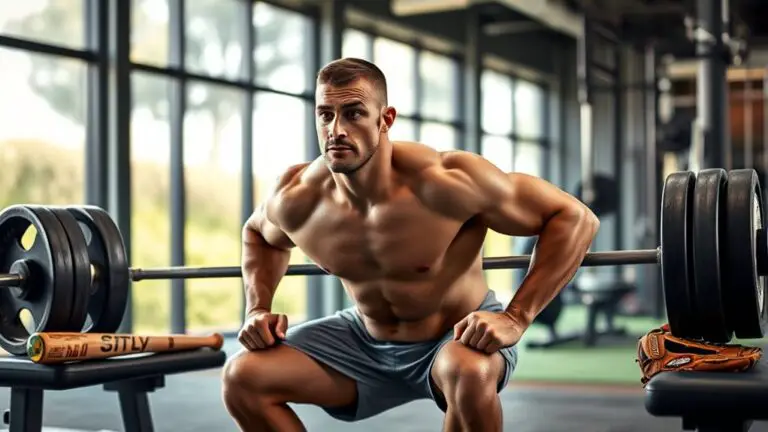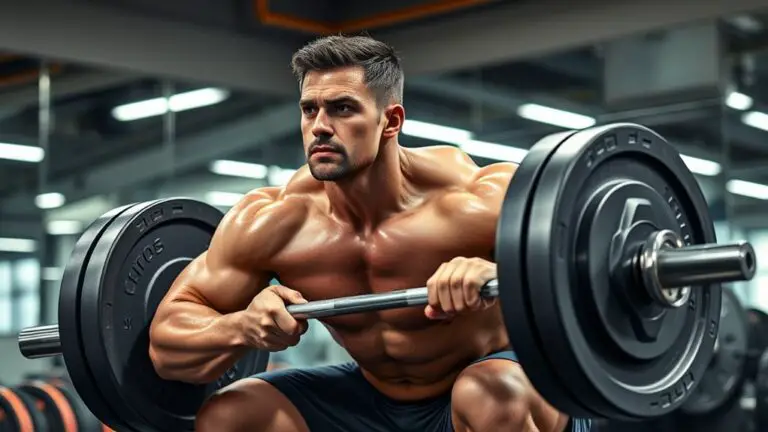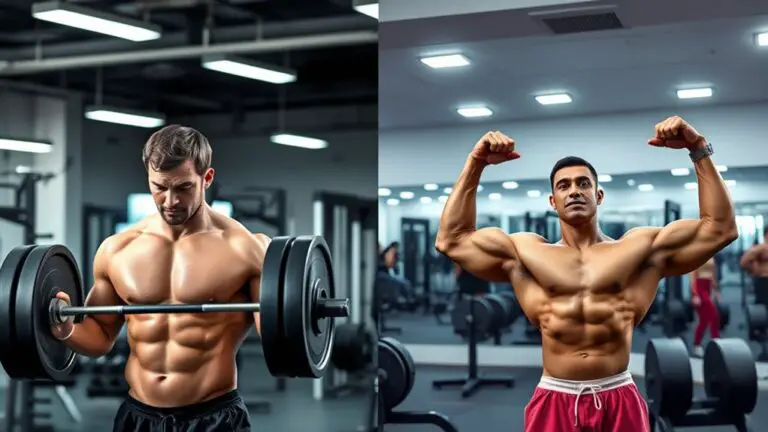How Different Eras of Bodybuilding Have Shaped Modern Gyms
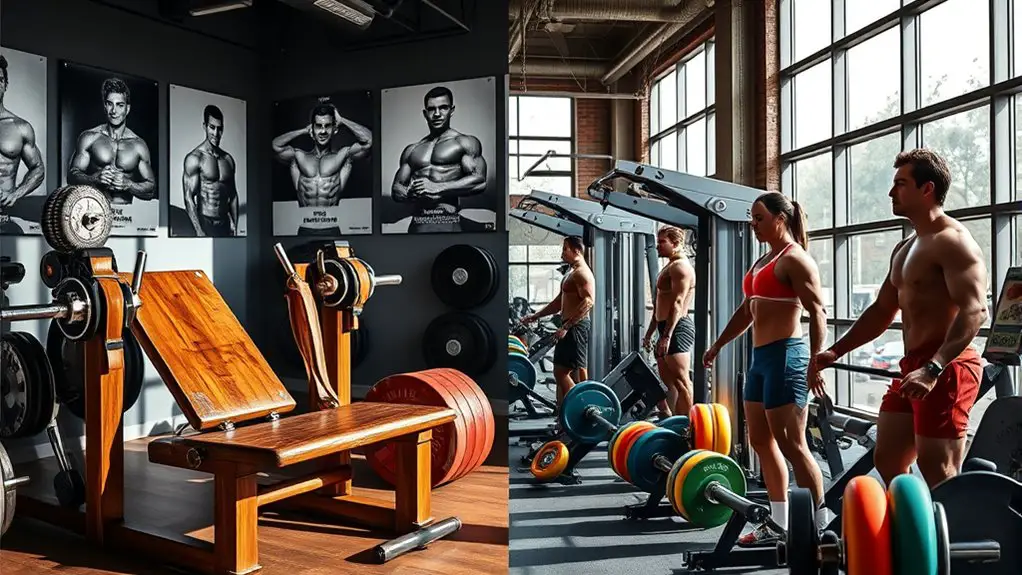
Different eras of bodybuilding have profoundly shaped modern gyms by influencing training techniques, accessibility, and community engagement. The early focus on aesthetics laid the groundwork for today’s fitness philosophies, while the Golden Age popularized bodybuilding culture. As commercial gyms emerged, they fostered inclusive environments that welcomed everyone. Technological advancements have streamlined workouts and performance tracking. Meanwhile, social media has created vibrant fitness communities. To gain deeper insights into these transformations, further exploration of these trends is essential.
The Birth of Bodybuilding: Early Influences and Pioneers
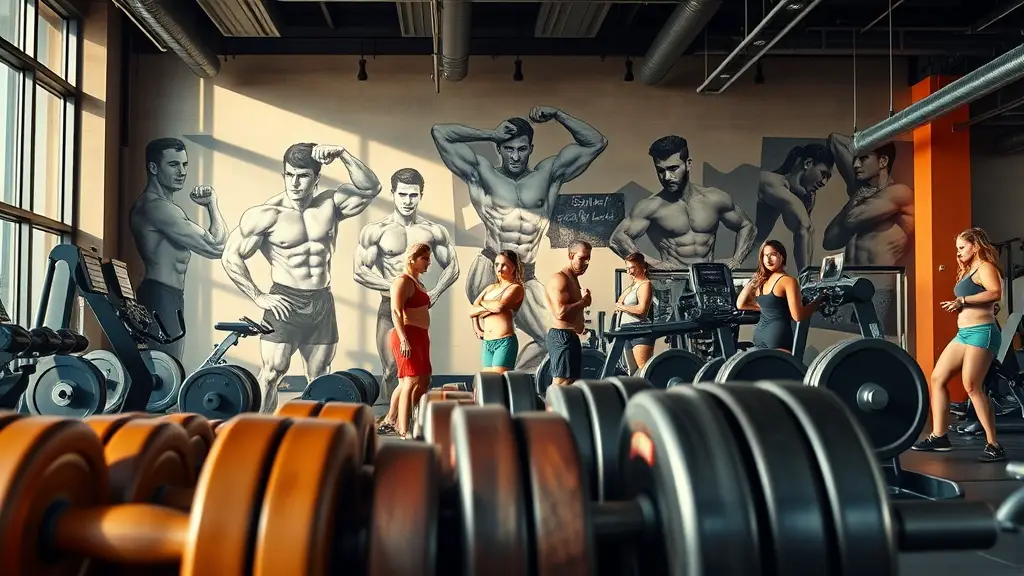
While many might think bodybuilding began in the modern era, its roots stretch back to ancient civilizations where strength and physique were celebrated. In Greece, for instance, athletes competed in events like the ancient Olympics, showcasing their physical prowess and aesthetic form. These early competitions were pivotal, laying the groundwork for what would evolve into bodybuilding as we understand it today.
Pioneering figures such as Eugen Sandow emerged in the late 19th century, promoting the idea of muscular development as an art form. He organized some of the first bodybuilding competitions, which attracted audiences and emphasized the importance of not just strength, but also symmetry and aesthetics. These early competitions marked a shift in how society viewed physical fitness, pushing the boundaries of what it meant to be strong. Consequently, the fascination with bodybuilding began to take shape, influencing future generations and laying the foundation for modern gyms.
The Golden Age of Bodybuilding: Icons and Innovations
During the Golden Age of Bodybuilding, iconic figures like Arnold Schwarzenegger and Franco Columbu not only shaped the sport but also set the standard for physical aesthetics. Their influence extended beyond personal achievements, inspiring innovations in training equipment that catered to the evolving needs of bodybuilders. As you explore this era, you’ll see how these legends and their advancements transformed bodybuilding into a cultural phenomenon.
Legendary Bodybuilders’ Influence
As the bodybuilding scene evolved in the mid-20th century, legendary figures emerged, reshaping the sport and leaving a lasting impact that resonates today. Icons like Arnold Schwarzenegger and Franco Columbu showcased legendary physiques that captivated audiences and inspired countless aspiring bodybuilders. Their emphasis on aesthetics, symmetry, and proportion set a standard that still influences modern training philosophies. You’ll find that many timeless techniques, such as the focus on compound movements and the importance of nutrition, originated during this era. These foundational practices laid the groundwork for contemporary bodybuilding routines, while the charisma of these legends helped popularize the sport globally. Ultimately, their influence is evident in today’s gyms, where their legacy continues to inspire both competitive athletes and fitness enthusiasts alike.
Equipment Evolution Over Time
The evolution of equipment in bodybuilding reflects not just technological advancements but also the changing philosophies around strength training and fitness. In the Golden Age, free weights dominated, emphasizing raw strength and muscle growth. Today, the integration of cardio machines and resistance bands offers a broader workout variety, catering to diverse fitness goals. Modern gym design incorporates circuit training setups, enhancing user experience by facilitating seamless shifts between exercises. Enhanced safety standards guarantee that equipment maintenance is a priority, minimizing injury risks. As the industry evolves, the focus remains on creating effective tools that not only build muscle but also promote overall health, making the gym an inclusive space for all fitness levels.
The Evolution of Training Techniques: From Weights to Functional Fitness
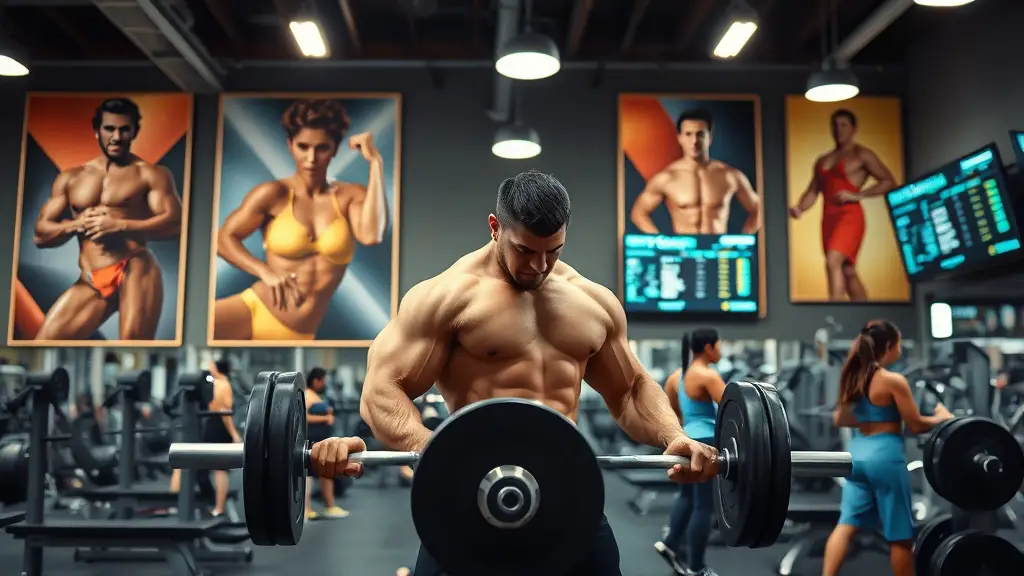
While traditional weightlifting has long been the cornerstone of bodybuilding, the landscape of training techniques has dramatically evolved, reflecting a shift toward functional fitness. You might’ve noticed that gyms now emphasize functional movements, integrating exercises that mimic everyday activities. This evolution is driven by principles like progressive overload, which remain essential for muscle growth but are now often applied in more dynamic ways.
High-intensity training and circuit training have gained popularity, focusing not just on strength but also on endurance and agility. These methods promote a holistic approach to fitness, pushing your body to adapt through varied and challenging workouts. By incorporating functional fitness into your routine, you’re not just building muscle; you’re enhancing your overall athleticism, making your workouts more efficient and effective. The modern gym experience now encourages you to engage in diverse training techniques that support both strength and functional performance, preparing you for real-life challenges. Additionally, incorporating activities like skipping rope can serve as an excellent full-body workout, engaging multiple muscle groups while improving cardiovascular health.
The Rise of Commercial Gyms: Accessibility and Community
As commercial gyms have proliferated, they’ve transformed the fitness landscape by providing affordable options that cater to a wider audience. You’ll find that these facilities not only lower the financial barrier to entry but also foster a social environment that encourages collaboration and motivation among members. This shift towards accessibility and community can greatly enhance your workout experience and commitment to fitness. Additionally, the variety of exercise and weightlifting equipment available at commercial gyms allows individuals to explore different fitness routines and find what best suits their goals.
Affordable Fitness Options
With the increasing demand for accessible fitness options, commercial gyms have emerged as pivotal players in the fitness landscape, fostering a sense of community among diverse groups. These facilities often offer budget memberships, making fitness more attainable for everyone. By providing community classes, they encourage social interaction and motivation, while online coaching expands accessibility beyond physical walls. Many gyms host fitness challenges that promote engagement and friendly competition, alongside local collaborations that strengthen ties within neighborhoods. Group discounts incentivize members to work out together, enhancing camaraderie. Additionally, wellness initiatives and inclusive programs cater to various fitness levels, ensuring that no one feels left out. This combination of affordability and community truly transforms the modern gym experience.
Social Workout Environment
The modern gym landscape has evolved into a vibrant social workout environment, driven by the rise of commercial fitness facilities that prioritize accessibility and community engagement. These gyms foster group dynamics, where shared goals and friendly competition create a motivating atmosphere. You’ll find that participating in group classes or training with friends enhances your commitment to fitness, as social interaction serves as a powerful motivation strategy. The diverse range of activities available encourages camaraderie, making workouts less isolating and more enjoyable. With amenities like lounges and communal spaces, these facilities facilitate connections among members, transforming the gym into a community hub. This shift not only promotes individual progress but also strengthens the overall culture of fitness, making it a shared journey.
The Impact of Technology: Equipment and Performance Tracking
While many still associate bodybuilding with traditional weights and manual tracking methods, the integration of technology into modern gyms has revolutionized how individuals approach their fitness journeys. You’re now able to utilize wearable technology, like fitness trackers and smartwatches, that monitor your heart rate, calories burned, and even rep counts in real-time. This instant feedback not only enhances motivation but also helps you optimize your workouts.
Moreover, performance analytics tools are becoming increasingly sophisticated, allowing you to analyze your progress over time. With apps that compile data from your sessions, you can identify strengths and weaknesses, tailor your routines, and set realistic goals. This level of detailed tracking provides a more personalized approach to bodybuilding, enabling you to make informed decisions about your training regimen. As technology continues to evolve, it’s clear that modern bodybuilding is as much about data-driven decisions as it is about physical strength. Additionally, using tools like a Gym Bike Calorie Calculator can further enhance your tracking capabilities by accurately measuring calories burned during workouts.
The Role of Social Media: Influencers and Online Communities
As technology enhances individual performance tracking, social media has emerged as a powerful force in shaping the bodybuilding community. You see, platforms like Instagram and TikTok allow influencers to share their journeys, workouts, and nutrition tips, effectively creating online communities that inspire and motivate others. These communities often foster a sense of belonging, where you can interact, ask questions, and exchange experiences.
| Influencer Type | Impact on Community |
|---|---|
| Fitness Coaches | Offer expert advice and plans |
| Amateur Bodybuilders | Share relatable journeys |
| Nutritionists | Provide dietary insights |
| Lifestyle Influencers | Promote wellness trends |
| Competitive Athletes | Showcase peak performance |
Through these interactions, you not only gain knowledge but also build connections that can transform your fitness journey. Ultimately, social media is reshaping bodybuilding, making it more accessible and community-driven than ever before.
The Future of Bodybuilding: Trends and Emerging Practices
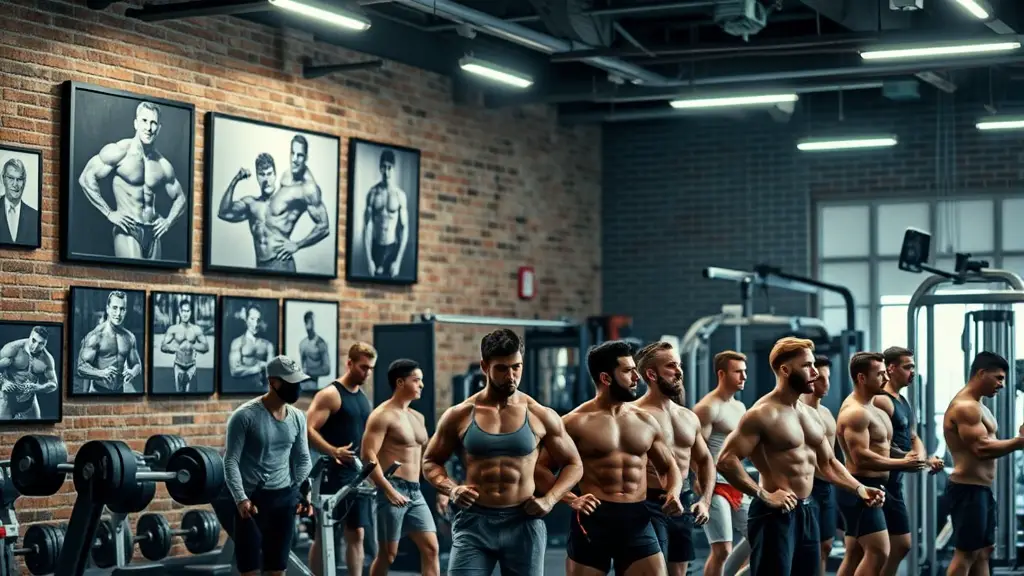
Emerging technologies and evolving fitness paradigms are poised to redefine bodybuilding in the coming years. As you navigate this new landscape, consider these key trends:
- Sustainable Bodybuilding: Eco-friendly gyms are becoming the norm, emphasizing sustainability in equipment and practices, fostering a culture of responsibility.
- Virtual Coaching: Personalized nutrition and hybrid training models are rising, allowing you to connect with coaches remotely for tailored workouts and meal plans that fit your lifestyle.
- Wellness Integration: Body positivity and mental health awareness are essential, encouraging a holistic approach to fitness that prioritizes overall well-being alongside physical goals.
These trends reflect a shift towards more personalized, inclusive, and environmentally conscious practices in bodybuilding. By embracing these emerging practices, you’re not just working out; you’re contributing to a community that values both individual growth and collective responsibility.
Frequently Asked Questions
How Have Dietary Practices Evolved in Bodybuilding Over the Decades?
Dietary practices in bodybuilding have evolved considerably, shifting from simple caloric intake to a focus on precise macronutrient ratios. You’re likely aware of how meal timing has become essential, with many athletes now consuming specific nutrients around workouts to optimize recovery and muscle gain. This evolution reflects a deeper understanding of nutrition science, emphasizing not just what you eat, but when you eat it, tailoring your diet to maximize performance and results.
What Role Do Steroids Play in Professional Bodybuilding History?
Steroid usage has historically played a controversial role in professional bodybuilding, often viewed as a shortcut to achieving extreme physiques. While they can enhance muscle growth and recovery, the health risks associated with chronic use can’t be ignored—think cardiovascular issues and hormonal imbalances. You might visualize a spectrum: on one side, the allure of rapid gains, and on the other, the potential long-term consequences. It’s a complex dynamic that continues to shape the sport.
How Did Gender Representation in Bodybuilding Change Over the Years?
Over the years, gender representation in bodybuilding’s evolved dramatically. Initially, women were often sidelined, but as media portrayal shifted, you’ve seen a surge in female empowerment. Events like women’s bodybuilding competitions gained visibility, showcasing strength and athleticism. This change has challenged stereotypes, allowing you to appreciate diverse body types and redefine femininity. Today, women aren’t just participants; they’re celebrated figures, inspiring others and reshaping the narrative around women in strength sports.
What Are the Major Controversies Surrounding Bodybuilding Competitions?
In bodybuilding competitions, major controversies often revolve around bodybuilding ethics and competition fairness. You’ve likely seen debates about the use of performance-enhancing drugs, which can skew results and raise questions about integrity. Additionally, judging criteria can be subjective, leading to accusations of favoritism or bias. These issues not only affect competitors but also impact the audience’s perception of the sport, creating a complex landscape where fairness and ethics are continually scrutinized.
How Has Bodybuilding Influenced Popular Culture Outside Fitness?
Bodybuilding’s influence on popular culture extends beyond fitness; it’s shaped fashion and media. You’ll notice muscle aesthetics have become a standard in advertising and film, promoting an idealized body image. Designers often draw inspiration from bodybuilding fashion, creating athletic wear that highlights physique. Social media amplifies this trend, showcasing influencers who embody these ideals, further intertwining bodybuilding with lifestyle and identity. This cultural crossover reflects society’s evolving views on strength and beauty.
